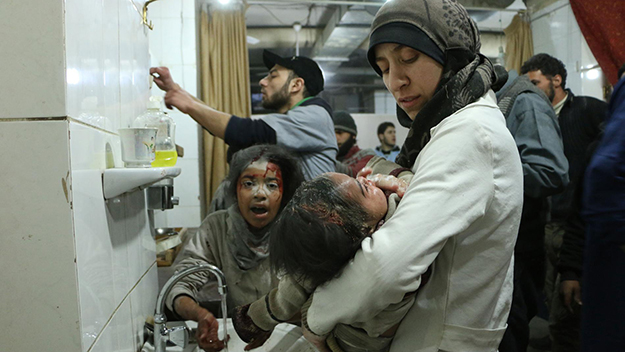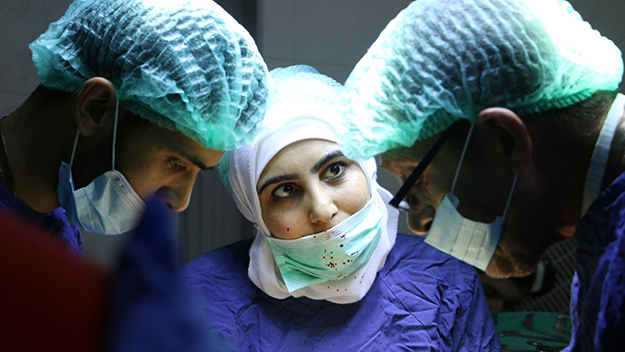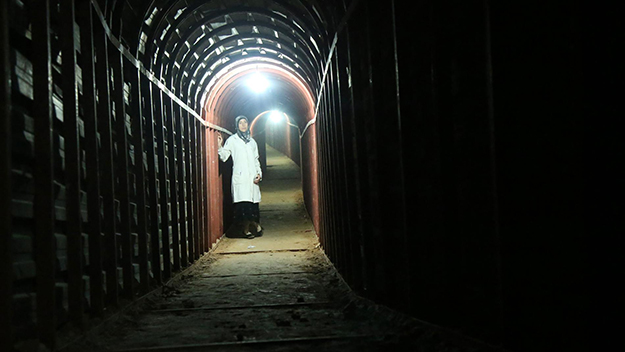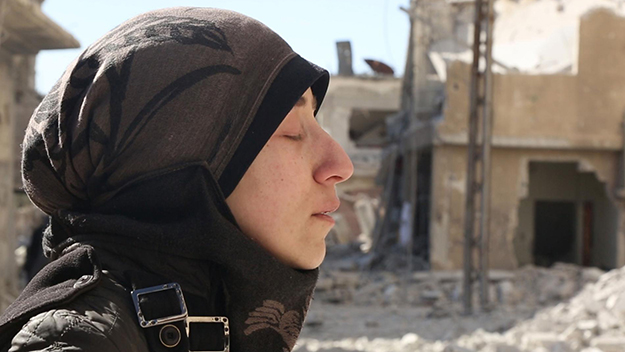Interview: Feras Fayyad

Images from The Cave (Feras Fayyad, 2019)
Feras Fayyad’s Oscar-nominated Last Men in Aleppo (2017), about a group of volunteer rescuers in the Syrian town of Aleppo, was an extraordinary documentary about trauma and a desperate hope for survival. His second feature documentary, The Cave, is set in besieged Ghouta in southwestern Syria, and follows up on Fayyad’s previous themes. It opens with the line, “War brings out the worst in humanity and the best in humanity.”
The Cave follows the extraordinary woman doctor Amani Ballor, who manages a hospital that, following increased Russian bombings and chemical attacks, becomes a permanent shelter for its residents. A hospital passageway leads to underground tunnels which offer refuge to women, children, the elderly, and, as the siege goes on, the region’s population at large. Some of the film’s most intensely claustrophobic scenes thus take place underground, while above, the earth hums with furious terror. In the hospital itself, Fayyad draws the operating room scenes with an uncanny eye for the choreography of bodies—a fine rhythmic balance between lull and terror, order and chaos.
But the filmmaker’s interest extends beyond the war and the massacre, even beyond the permanent scars of this particularly bloody conflict. To put it in Western pop-culture terms, what Fayyad is truly concerned with is the sum total of toxic masculinity. The lead women in his new film—particularly Dr. Amani, but also all the nurses serving under her to save lives—are under a double siege, constantly reminded that when the war ceases, they will return to a world in which their profession, their demands for equality, their fierce independence and refusal to be underlings or housewives or servants, will continue to put them in mortal danger.
Film Comment sat down with Fayyad during the Toronto International Film Festival to discuss The Cave, in wide release on Friday, October 18.
The Cave is so immersive in how it engages our senses, starting with the images. What did you discuss with your cinematographers [Mohammad Kheir Al Shami, Ammar Suleiman, and Mohammad Eyad], before the shoot?
We actually looked at the 19th century European painting, particularly The Death of Socrates, by Jacques-Louis David, and a number of paintings by Georges De La Tour.
What struck you about these paintings?
In The Death of Socrates, for example, it was the depth of field. The entire situation is built around a group. I explained to my cinematographers that we needed a camera in a moving framing. If you want to move the camera, you have to move it behind the persons; you cannot just step in front of them. In this sense, a character’s eye is guiding us, while, at the same time, we are building a sense of depth.
That’s how the camera functions during the scenes in the operating room.
You have a sense of this group of bodies, persons, working together, in space.

While depth helps us catch small details, such as, for example, the cellular phone that’s playing classical music videos during surgery?
Yes. Whatever happens, you try to make the camera sit, to resist moving, so that you focus on the behavior of the people rather than keep searching for new details. I thought in terms of three main elements: behavior, time, and event. First you need to focus on the character. Then you see how time affects her. The character is always in the foreground and the thing happening, the event, in the background.
In this sense, the drama is in the body.
Exactly. My cinematographers were shy at first about filming women. They feared looking at them so keenly, but I insisted that they should keep in mind that moving the camera means disrespecting the character. This helped shape their response. They began to see Amani as an extraordinary person who faces terrible stereotypes. They engaged with her more, which wasn’t easy. Nor was it easy for Amani, because there were so many bystanders always watching her.
I guess Amani herself didn’t know how intense the camera would be?
Letting the camera in was one of the bravest things she did. In this way, Amani leads the camera. We build a mise en scène that’s an “L,” and which remains close to her. And she managed to build up her strength, allowing the camera to observe her for hours, for two years. There are so many moments when she is doing nothing, just observing, or waiting. Her stillness builds a kind of journey through time.
What were the logistics of shooting in a claustrophobic space?
We had small digital Canon cameras and also a small crew—two cinematographers most of the time, and the third one coming and going. Basically, I always had two teams. I worked with one and the other worked alone, in another location.
What kind of lenses did you use to shoot in the dark tunnels?
We used regular lenses. We tried to imitate the eye, so a 24mm lens that you can buy from any shop. Also, the Canon digital cameras are excellent for photography, which was the craft we wanted to use—they’re very good with shadows and darkness. If we needed to light a scene, we used our cellphones. Generally, we tried to use the same technology that most people around us would have.
If I had the privilege and the luxury, of course, I would have loved to shoot on 35mm. But the candle scene in the beginning is the only one we shot on film.

Did you find that film is better at conveying textures?
It gives a sense of warmth. We tried at first shooting the candle scene in digital, but I felt that we needed that first moment in the film to be actually on film, to introduce the idea of classical painting—and also what the candle represents, in history, and in paintings such as those by La Tour. It is an accessible metaphor to grasp, and it also references the senses. But then, of course, shooting the rest of the film on digital also allowed us to have the 400 hours of footage by the end, filmed by two teams. You never know how your story will end, so you shoot many things at the same time.
I’m curious how the team split up in the most chaotic scenes, such as the one that captures the victims in the hospital, immediately after the chemical attack. One camera focused on Amani—and the others?
They focused on the children being brought in, but particularly on the small girls. I wanted to capture how these small girls and the women helping them rise up in this situation, and how a man would react differently. We decided on this in the early stages, as the material kept shaping up, and then followed up on this in the editing.
The chemical attack scene is very raw. We wanted to keep it as raw as possible.
What does raw mean in this case?
It means minimal editing, because it’s a record of a human rights crime. The power of that moment is more powerful than anything we could have done with it.

Sound is also incredibly important and seems to be amplified in places.
It was, sometimes. We didn’t want to cross the line, but the film is about the women’s perspective. So we amplified the sound to communicate their hypersensitivity, caused by trauma.
Such as when Dr. Amani says she hears the bombs much louder than they are?
We amplified the sound of bombs in that scene, to reflect how loud Amani hears them, and how loud I hear them—since I’m as traumatized, and as hypersensitive, as she is. In another scene, we amplified Amani’s breathing. The production sound was so bad that we had to clean it first, and then built on that. The sound in the film is overwhelming, but, at the same time, it’s truer to reality, because when the bomb goes off on the ground in Syria, the earth shakes, and you feel the shaking all inside your body. You hear the feet pounding, and as the medics push the stretcher, you hear its rattle. We tried to bring all these sounds back in.
Cinematic reality requires so much work in post-production. I spoke about this early on with the sound designer [Peter Albrechtsen]. We talked about what additional sounds to capture, to record the shock that we feel in the moment. Then he pushed the sound to make you feel the environment. For example, when the planes come down, we at first didn’t have that exact feeling of being under attack, because we failed to record the sound of planes flying low. We needed the particular hissing sound that the planes make.
You also used classical music, not just as it plays on the iPhone in the operating room, but also directly on the soundtrack.
We used a piece from Mozart’s Requiem, at the moment with the surgeon, Dr. Salim, and then as another man runs through the streets with a plate of food—it’s such a surreal sequence, like something out of Greek mythology. The man could be killed right there, as he’s running, just for bringing the food. I wanted to emphasize that we’re in a place where even the simplest things are incredible.
But we also build many moments of stillness, by actually taking the sound out. That’s because in reality, on the ground, in Syria, the bombs were going off every few minutes. And we had such sensitive microphones that they were recording all that noise. So we needed to clean it out, to get closer to the persons around us, and to avoid making another “noisy film,” which focuses only on the war’s destruction. You need to listen to how your protagonists listen, and hear what they hear, to understand their environment, and to understand how they survive.
Ela Bittencourt works as a critic and curator in the U.S. and Brazil and consults for a number of international film festivals. She also runs the film site, Lyssaria.







